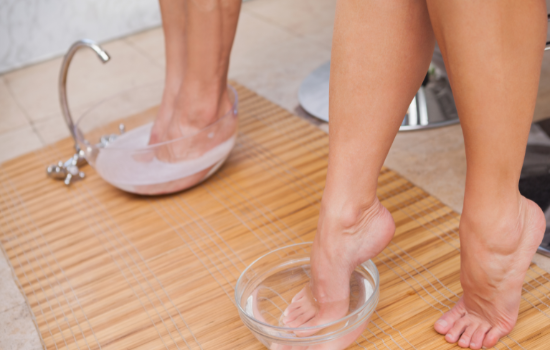Epsom Salt for Toenail Fungus: Natural Remedy & Benefits Explained
Contents
Toenail fungus is an all-too-common problem that can be frustrating and embarrassing. Officially known as onychomycosis, it causes thickened, discolored, and brittle nails, often accompanied by discomfort or an unpleasant odor.
While there are various treatments available, ranging from prescription medications to over-the-counter creams, many people are turning to natural remedies like Epsom salt for relief.
But does it work? Let’s explore how Epsom salt might help with toenail fungus and how to use it effectively.
What is Epsom Salt?
Epsom salt, scientifically known as magnesium sulfate, is a naturally occurring mineral compound renowned for its therapeutic properties.
Despite its name, it’s not salt but rather a crystal-like substance that dissolves easily in water.
For centuries, people have used Epsom salt in baths and foot soaks to relieve muscle soreness, reduce inflammation, and promote relaxation.
Its antifungal and antimicrobial properties make it an intriguing option for managing toenail fungus.
How Epsom Salt Works Against Toenail Fungus?
Toenail fungus thrives in warm, moist environments and can be notoriously stubborn to treat.
Epsom salt may help in the following ways
- Soothing Inflammation: The antifungal properties of magnesium sulfate can help reduce the redness, swelling, and irritation associated with fungal infections.
- Softening the Nail: Epsom salt soaks can soften thickened nails and surrounding skin, making it easier to trim affected areas and apply antifungal treatments more effectively.
- Drying Effect: Regular soaks may help draw out moisture from the nail bed, creating a less hospitable environment for the fungus to thrive.
- Exfoliating Dead Skin: The abrasive texture of Epsom salt helps gently exfoliate dead skin, removing debris and fungal spores.
Benefits of Using Epsom Salt
- Epsom salt is affordable, easy to find, and gentle on the skin.
- Its natural properties make it a great option for those who prefer holistic approaches or want to supplement conventional treatments.
- Plus, soaking your feet in warm water with Epsom salt can be incredibly relaxing and a bonus for your overall well-being.
How to Use Epsom Salt for Toenail Fungus?
If you’re considering Epsom salt as part of your toenail fungus treatment, follow these steps for an effective foot soak
Prepare the Soak
- Fill a basin or tub with warm water (enough to submerge your feet).
- Add ½ cup of Epsom salt and stir until dissolved.
Soak Your Feet
- Submerge your feet in the solution and soak for 20-30 minutes.
- For the best results, repeat this process daily.
Dry Thoroughly
- After soaking, pat your feet dry with a clean towel, paying extra attention to the spaces between your toes. Moisture can exacerbate fungal growth.
Apply Additional Treatments
- Consider applying an antifungal cream or natural remedy like tea tree oil to your nails after the soak for a multi-pronged approach.
Limitations of Epsom Salt for Toenail Fungus
While Epsom salt can provide relief and improve nail health, it’s not a standalone cure for toenail fungus.
The fungus often resides deep within the nail bed, where topical treatments and soaks might not reach.
For severe or persistent cases, you may need to consult a healthcare professional for prescription medications or other advanced treatments.
 Tips to Prevent Toenail Fungus
Tips to Prevent Toenail Fungus
To complement your Epsom salt routine and reduce the risk of reinfection, follow these preventative tips:
- Maintain Good Foot Hygiene: Wash your feet daily and keep them dry.
- Wear Breathable Footwear: Opt for shoes made from materials that allow air circulation, and avoid tight-fitting styles.
- Change Socks Regularly: Wear moisture-wicking socks and replace them as needed, especially if your feet sweat heavily.
- Avoid Walking Barefoot: In public places like gyms, pools, or locker rooms, always wear protective footwear.
- Trim Nails Properly: Cut your nails straight across and avoid cutting them too short to reduce the risk of injury and infection.
When to Seek Professional Help?
If you’ve been diligently using Epsom salt soaks and other remedies without improvement, or if the infection worsens, it’s time to consult a doctor.
Severe cases of toenail fungus may require oral antifungal medications, laser treatments, or other medical interventions.
Final Thoughts
Epsom salt is a versatile and affordable home remedy that can play a role in managing toenail fungus. While it’s not a magic bullet, its soothing and antifungal properties can provide relief and support other treatments.
By incorporating Epsom salt into your foot care routine and following preventative measures, you can take a step toward healthier, fungus-free nails.
Have you tried Epsom salt for toenail fungus? Share your experience in the comments below, and don’t forget to explore other natural remedies on our blog!



